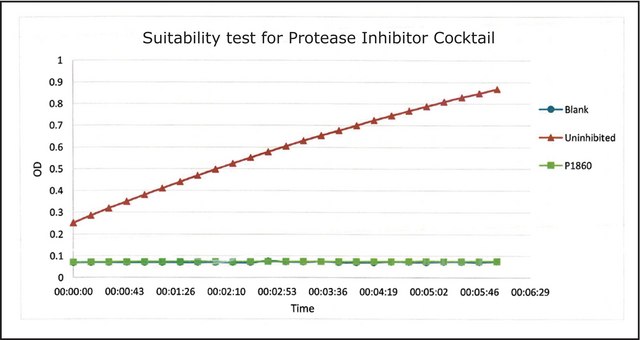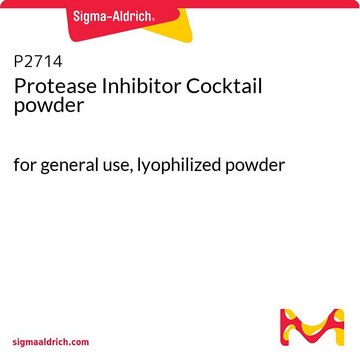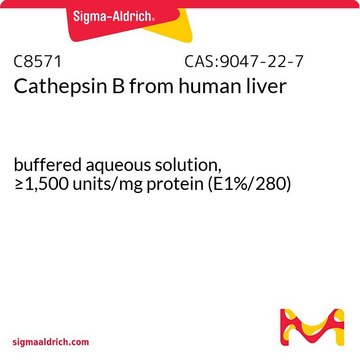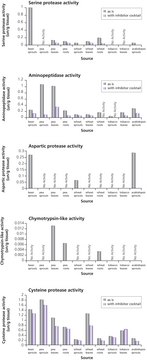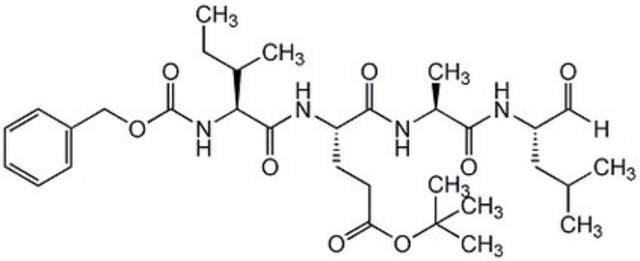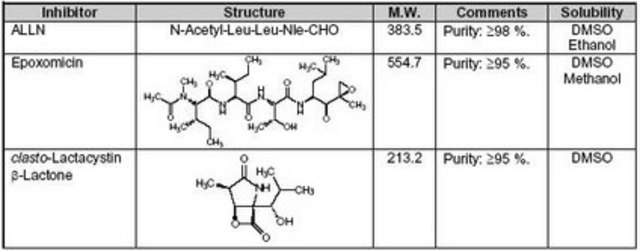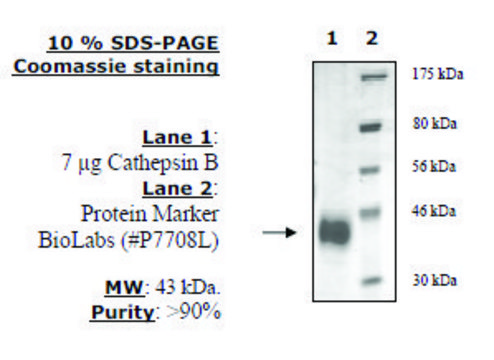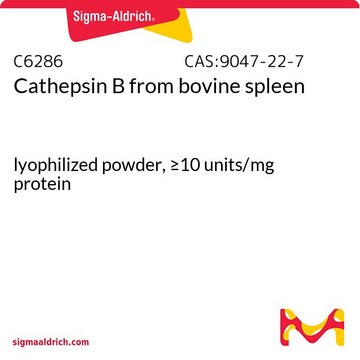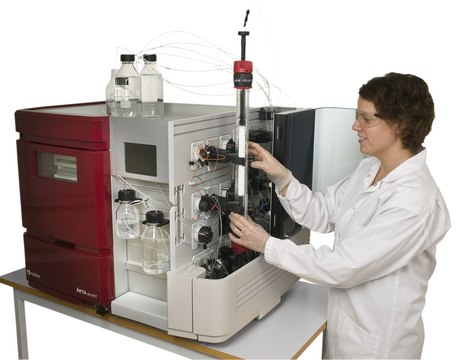539175
Proteasome Inhibitor IV
The Proteasome Inhibitor IV controls the biological activity of Proteasome. This small molecule/inhibitor is primarily used for Protease Inhibitors applications.
Synonym(s):
Proteasome Inhibitor IV, Z-GPFL-CHO
Sign Into View Organizational & Contract Pricing
All Photos(1)
About This Item
Empirical Formula (Hill Notation):
C30H38N4O6
Molecular Weight:
550.65
UNSPSC Code:
12352200
Recommended Products
Quality Level
Assay
≥90% (HPLC)
form
lyophilized solid
manufacturer/tradename
Calbiochem®
storage condition
OK to freeze
protect from light
color
white
solubility
DMSO: 5 mg/mL
shipped in
ambient
storage temp.
−20°C
General description
A tetrapeptide aldehyde that acts as a highly selective and potent proteasomal inhibitor (Ki = 1.5 µM for branched chain amino acid preferring, 2.3 µM for small neutral amino acid preferring, and 40.5 µM for chymotrypsin-like activities; IC50 = 3.1 µM for peptidyl-glutamyl peptide hydrolyzing activity). Shown to be a weak inhibitor of trypsin-like proteasomal activity.
Biochem/physiol Actions
Cell permeable: no
Primary Target
branched chain amino acid preferring,small neutral amino acid preferring, chymotrypsin-like activities
branched chain amino acid preferring,small neutral amino acid preferring, chymotrypsin-like activities
Product does not compete with ATP.
Reversible: no
Target Ki: 1.5 µM, 2.3 µM, and 40.5 µM against branched chain amino acid preferring, small neutral amino acid preferring, and chymotrypsin-like activities of proteasomes, respectively
Packaging
Packaged under inert gas
Warning
Toxicity: Standard Handling (A)
Sequence
Z-Gly-Pro-Phe-Leu-CHO
Reconstitution
Following reconstitution aliquot and freeze (-20°C). Stock solutions are stable for up to 6 months at -20°C.
Other Notes
Oberdorf, J., et al. 2001. Biochemistry40, 13397.
Cardozo, C., et al. 1999. Biochemistry38, 9768.
Eleuteri, A.M., et al. 1997. J. Biol. Chem.272, 11824.
Orlowski, M., et al. 1997. Biochemistry36, 13946.
Vinitsky, A., et al. 1994. J. Biol. Chem.269, 29860.
Cardozo, C., et al. 1999. Biochemistry38, 9768.
Eleuteri, A.M., et al. 1997. J. Biol. Chem.272, 11824.
Orlowski, M., et al. 1997. Biochemistry36, 13946.
Vinitsky, A., et al. 1994. J. Biol. Chem.269, 29860.
Legal Information
CALBIOCHEM is a registered trademark of Merck KGaA, Darmstadt, Germany
Storage Class Code
11 - Combustible Solids
WGK
WGK 1
Flash Point(F)
Not applicable
Flash Point(C)
Not applicable
Certificates of Analysis (COA)
Search for Certificates of Analysis (COA) by entering the products Lot/Batch Number. Lot and Batch Numbers can be found on a product’s label following the words ‘Lot’ or ‘Batch’.
Already Own This Product?
Find documentation for the products that you have recently purchased in the Document Library.
J Oberdorf et al.
Biochemistry, 40(44), 13397-13405 (2001-10-31)
Misfolded proteins in the endoplasmic reticulum (ER) are degraded by N-terminal threonine proteases within the 26S proteasome. Each protease is formed by an activated beta subunit, beta5/X, beta1/Y, or beta2/Z, that exhibits chymotrypsin-like, peptidylglutamyl-peptide hydrolyzing, or trypsin-like activity, respectively. Little
A Vinitsky et al.
The Journal of biological chemistry, 269(47), 29860-29866 (1994-11-25)
Evidence indicates that a component of the multicatalytic proteinase complex (MPC) that preferentially cleaves bonds after branched chain amino acids (BrAAP) is a major factor responsible for the protein-degrading activity of the MPC. We report here the synthesis of substrate-related
A M Eleuteri et al.
The Journal of biological chemistry, 272(18), 11824-11831 (1997-05-02)
Amino acid sequencing of subunits of the multicatalytic proteinase complex (MPC) isolated from bovine spleen showed an almost complete replacement of the X, Y, and Z subunits, constitutively expressed in most tissues, by the interferon-gamma-inducible LMP7, LMP2, and MECL1 subunits.
C Cardozo et al.
Biochemistry, 38(30), 9768-9777 (1999-07-28)
Two catalytic components of the multicatalytic proteinase complex (MPC, proteasome) designated as chymotrypsin-like (ChT-L) and branched chain amino acid preferring (BrAAP) cleave bonds after hydrophobic amino acids. The possible involvement of the ChT-L and peptidylglutamyl-peptide hydrolyzing (PGPH) activities in the
M Orlowski et al.
Biochemistry, 36(45), 13946-13953 (1997-12-31)
Exposure to [14C]-3,4-dichloroisocoumarin (DCI) of multicatalytic proteinase complexes (MPC) isolated from bovine pituitary and spleen leads to label incorporation into several beta-type subunits, to rapid inactivation of the chymotrypsin-like (ChT-L) activity, and to a slower inactivation of other activities of
Our team of scientists has experience in all areas of research including Life Science, Material Science, Chemical Synthesis, Chromatography, Analytical and many others.
Contact Technical Service